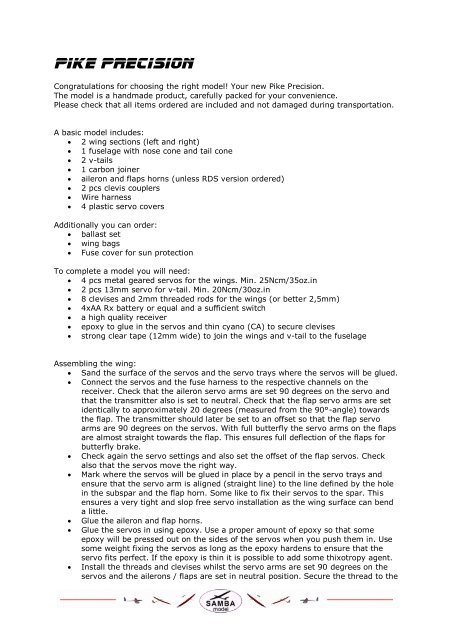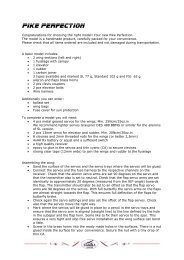Create successful ePaper yourself
Turn your PDF publications into a flip-book with our unique Google optimized e-Paper software.
<strong>Pike</strong> Precision<br />
Congratulations for choosing the right model! Your new <strong>Pike</strong> Precision.<br />
The model is a handmade product, carefully packed for your convenience.<br />
Please check that all items ordered are included and not damaged during transportation.<br />
A basic model includes:<br />
2 wing sections (left and right)<br />
1 fuselage with nose cone and tail cone<br />
2 v-tails<br />
1 carbon joiner<br />
aileron and flaps horns (unless RDS version ordered)<br />
2 pcs clevis couplers<br />
Wire harness<br />
4 plastic servo covers<br />
Additionally you can order:<br />
ballast set<br />
wing bags<br />
Fuse cover for sun protection<br />
To complete a model you will need:<br />
4 pcs metal geared servos for the wings. Min. 25Ncm/35oz.in<br />
2 pcs 13mm servo for v-tail. Min. 20Ncm/30oz.in<br />
8 clevises and 2mm threaded rods for the wings (or better 2,5mm)<br />
4xAA Rx battery or equal and a sufficient switch<br />
a high quality receiver<br />
epoxy to glue in the servos and thin cyano (CA) to secure clevises<br />
strong clear tape (12mm wide) to join the wings and v-tail to the fuselage<br />
Assembling the wing:<br />
Sand the surface of the servos and the servo trays where the servos will be glued.<br />
Connect the servos and the fuse harness to the respective channels on the<br />
receiver. Check that the aileron servo arms are set 90 degrees on the servo and<br />
that the transmitter also is set to neutral. Check that the flap servo arms are set<br />
identically to approximately 20 degrees (measured from the 90°-angle) towards<br />
the flap. The transmitter should later be set to an offset so that the flap servo<br />
arms are 90 degrees on the servos. With full butterfly the servo arms on the flaps<br />
are almost straight towards the flap. This ensures full deflection of the flaps for<br />
butterfly brake.<br />
Check again the servo settings and also set the offset of the flap servos. Check<br />
also that the servos move the right way.<br />
Mark where the servos will be glued in place by a pencil in the servo trays and<br />
ensure that the servo arm is aligned (straight line) to the line defined by the hole<br />
in the subspar and the flap horn. Some like to fix their servos to the spar. This<br />
ensures a very tight and slop free servo installation as the wing surface can bend<br />
a little.<br />
Glue the aileron and flap horns.<br />
Glue the servos in using epoxy. Use a proper amount of epoxy so that some<br />
epoxy will be pressed out on the sides of the servos when you push them in. Use<br />
some weight fixing the servos as long as the epoxy hardens to ensure that the<br />
servo fits perfect. If the epoxy is thin it is possible to add some thixotropy agent.<br />
Install the threads and clevises whilst the servo arms are set 90 degrees on the<br />
servos and the ailerons / flaps are set in neutral position. Secure the thread to the
clevis with extra thin CA as this is a place with some slop. Check also thoroughly<br />
the clevis pins going into the horns and servo arms. There are clevises that can be<br />
poorly made in this special detail. Use the inner most hole on the servoarms<br />
possible to ensure full power of the servo yet providing full throw.<br />
It is recommended to install clear tape on the ends of the wings. This will prevent<br />
the paint being ripped off when the tape is applied / removed every time you go<br />
flying.<br />
Adjust the aileron throw to 20/12mm.<br />
Adjust the aileron throw on flaps to 9/6mm<br />
Adjust the crow brake flaps to as much as possible (70-85 degrees is good)<br />
Adjust the crowbrake on ailerons to 7mm up<br />
Adjust the camber for launch to 10mm flap and aileron equal.<br />
Camber for thermal is +3mm measured on flaps and equal along the whole<br />
trailing edge. More thermal camber might be used in special weather conditions.<br />
Camber/relex for speed is -1mm for F3B but for F3F neutral is used.<br />
Snap flap (elevator – flap mix) can be used up to 10mm on full elevator throw.<br />
Beware snap flap might not be the most effective in all conditions / flying styles.<br />
Cut the servo covers carefully so that the servo horns fit underneath the bumps if<br />
needed.<br />
Assembling the fuselage:<br />
Install the “fuse to wing”-harness in the fuselage. Roughen the green connector<br />
and fuselage fitting before you glue it.<br />
Install the receiver battery and receiver before servos. 2+2 AA batteries are<br />
recommended though 2+3 can also be fitted. It is recommended to pack the<br />
receiver in bubble plastic or equal to absorb shocks.<br />
New LiFe battery is possible. Ensure servos can use the voltage and secure the<br />
front end of the battery to absorb shocks. Use a voltage regulator if needed.<br />
Install the fuselage servos<br />
Install the receiver. If 2.4 receiver with long antennas is used there is a slot on<br />
the underside of the inner nose cone to tape on one antenna. Drill a hole so that<br />
the antenna comes out without making a sharp bend. Tape the antenna to the<br />
inner nose cone. The second (or more) antenna is taped on the receiver side<br />
making sure it is as free as possible and not hidden by electronics or wires.<br />
The outer nose cone is of glassfiber and signals will pass thru with no hindering. A<br />
range test will show that your installation is correct.<br />
Glue the 2mm clevis couplers to the pushrods after removing the outer Teflon<br />
layer of the pushrods and roughening the glassfiber surface. Pinch the coupler<br />
with a plier to ensure tight fit.<br />
Check the connection thoroughly.<br />
Glue the pushrod tube to the fuselage between canopy and the leading edge<br />
Adjust the elevator so that it is in neutral checking top and bottom airfoil. Full<br />
throw is 5mm up and 5mm down. At full crow the elevator goes down<br />
approximately 5mm depending on crow settings for wing. It is good to ensure<br />
more down throw (+10mm) possible after crow brake is set.<br />
Launch setting is -1mm<br />
Rudder throw +/- 6mm<br />
Assembling the model:<br />
Attach the two v-tails to the fuse and secure with a tiny piece of tape round the<br />
front and lower part. Carefully push the ball link in place and check that they<br />
move freely. Pinch the plastic with a plier to free them up if they are tight. The<br />
ball link can be removed by using a flat screwdriver clicking it off again. Tape on<br />
the tail cone.
Adjust the tow hook to 100mm from the leading edge.<br />
Attach the wing with clear tape to secure at top and around leading edge.<br />
Check and adjust the CG (center of gravity). A suitable CG to start off is 100-<br />
102mm from leading edge.<br />
Check range according to transmitter specifications.<br />
If you can not get the necessary range you need to:<br />
1) Check antenna locations<br />
2) Try another transmitter<br />
3) Try another receiver<br />
Settings:<br />
All the latest detailed settings can be found on www.F3J.com.<br />
These are settings from some of the world’s best pilots.<br />
You will find these setting a very good starting point.<br />
<strong>Model</strong> can not stay long in the sun without silver protection covers (including fuselage) to<br />
prevent excessive heating up of the model as there could appear some deformations of<br />
model parts when model is overheated or the surface could get distortions.<br />
F3B joiner is made of high modulus carbon fibers UMS<br />
F3F joiner is made of standard carbon fibers<br />
After harder landings it is necessary to check the joiner and look for cracks as it could<br />
cause failure of complete model in the next flights.<br />
We hope you will be satisfied with your new model. If you have any questions be sure to<br />
look at our webpages. Additional info about the setup and detailed pictures can be found<br />
there.<br />
Regards<br />
<strong>Samba</strong> <strong>Model</strong><br />
Webpage: www.F3J.com / Email: samba@f3j.com



